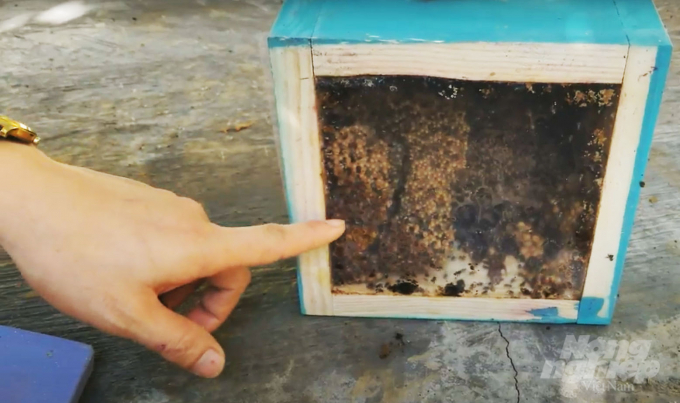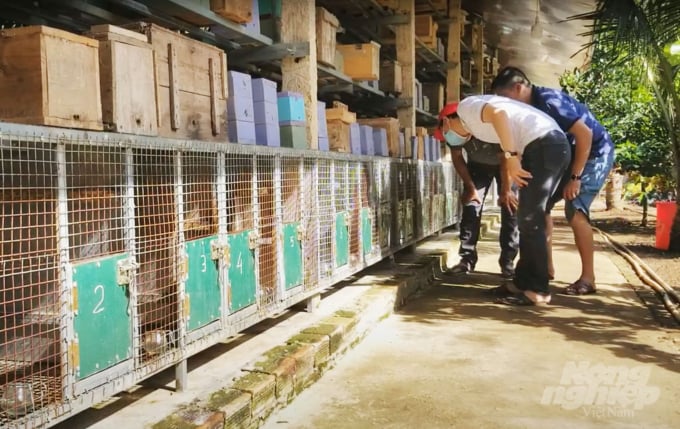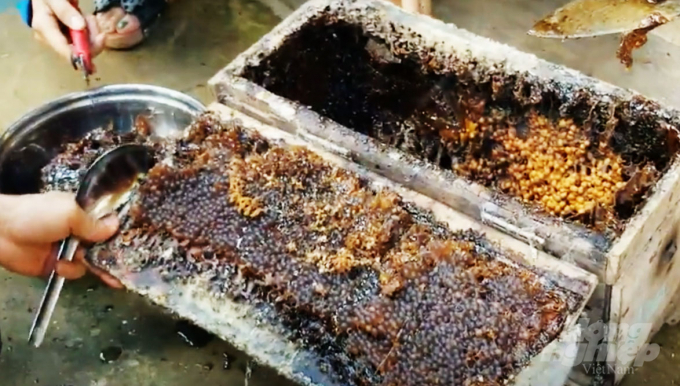November 27, 2025 | 20:09 GMT +7
November 27, 2025 | 20:09 GMT +7
Hotline: 0913.378.918
November 27, 2025 | 20:09 GMT +7
Hotline: 0913.378.918
We visit the family of Mr. Tran Van Thuc, hamlet 3, Duc Pho commune (Cat Tien district, Lam Dong), a pioneer in implementing the local stingless bee raising model. The first impression, when entering his 2-hectare garden full of rambutans, is the hundreds of wooden boxes hanging around the trees in the garden. While sharing with us, Mr. Thuc shows that he is very proud of his profession and his over 10 years of experience in beekeeping.

Mr. Tran Van Thuc hangs boxes of stingless bees in his family's rambutan garden. Photo: M.H.
According to Mr. Thuc, in 2008, his family let a friend who is a beekeeper bring bees to live in the garden, looking for flowers to suck nectar. When they left, he discovered a honeycomb inside a plastic pipe in the house. He took out the honey to try it out and found it very delicious, through research, he learned that the honey of stingless bee is a very rare type, so he was curious and decided to cut the pipe and take the honeycomb out to the garden to try raising it.
Nearly a year later, the bees grew well and produced a lot of honey. Since then, Mr. Thuc started researching and learning the farming process, about how to get honey reasonably and preserve honey products in a secure manner.
After more than 7 years of trial farming and research, by 2015, Mr. Thuc had finally succeeded in separating and breeding stingless bees.

The crate for stingless bees is compact and simple, the investment cost is not too high. Photo: M.H.
According to Mr. Thuc, raising stingless bees is not hard labor and does not cost much money because he does not have to worry about them getting fed or getting sick. However, bees are also very sensitive to changes in the environment such as hot, cold, sunny, and rainy weather that can make the bees sick.
Up until now, Mr. Thuc has developed a colony of stingless bees with the number of up to 170 swarms, and each year he collects about 150 liters of honey. With the current market price of VND 900,000 - 1,200,000/liter of honey, depending on the period, Mr. Thuc can earn more than VND 150 million a year. In addition, for each swarm of stingless bees after being successfully separated from the nest, he sells the seeds to other households for VND 1,500,000/swarm.

Stingless bee raising model of Mr. Do Van Nghia's family in Cat Tien town. Photo: M.H.
Similarly, Mr. Do Van Nghia, who lives in Residential group 15, Cat Tien town, has been raising stingless bees for honey for more than 7 years. However, instead of hanging the beehive on a tree, Mr. Nghia chose to build a firm house to create a stable "dwelling" for the bees.
In the raising process, Mr. Nghia gradually replaced the original crude bamboo and wooden trunks into small wooden boxes divided into many parts, one side covered with white plastic for easy observation and classification of egg layers, honey, and the number of bees. Moreover, collecting honey would not reduce the number of bees in a swarm.
At present, Mr. Nghia owns hundreds of bee swarms, possessing commercial stingless bee species, each year he harvests over 200 liters of honey, with a turnover of over VND 200 million.

Honey of stingless bee currently has a price of VND 900,000 - 1,200,000/liter, which signifies that the farmers are making high profits. Photo: M.H.
In order for this profession to develop in a stable and sustainable direction, in the coming time, the localities will establish a beekeeping club, giving members the opportunity to meet, exchange and share experiences. At the same time, farmers are encouraged to build brands, improve product quality, expand association scale in farming and proceed to develop OCOP-specified products to promote the popular local product.
“Stingless bee also has a queen bee like other bees, the special thing is that this kind of bee does not leave like micrapis or apis dorsata… when there are many “troops” in the colony, they separate into other swarm and so the number of nests is multiplied. The raising space can be placed under the porch, tree canopy, easily making use of many places in the garden, especially the bee is very friendly to people", said Mr. Do Nghia, living in Residential group 15, Cat Tien town.

(VAN) According to Mr. Vo Minh Thanh, Director of the Tay Ninh Department of Agriculture and Environment, Resolution 57 has created a new development pathway for the locality, shifting from traditional toward modern agriculture.
/2025/11/26/4909-2-154329_878.jpg)
(VAN) Pearl grouper farming in HDPE cages not only delivers economic efficiency but also contributes to protecting the environment, creating jobs, and promoting marine-based experiential tourism.

(VAN) The model of making a living under the forest canopy through the agroforestry system in Van Son commune, Bac Ninh province, is expected to generate an annual income of approximately VND 30 million/ha.

(VAN) Many enterprises in Can Tho are harnessing natural energy and reducing greenhouse gas emissions in their production processes, thereby contributing to the promotion of a sustainable green transition.
/2025/11/24/3536-2-112800_176.jpg)
(VAN) Dong Nai now has tens of thousands of hectares of forests certified for sustainable management, and this area will continue to be expanded in the coming period.

(VAN) Vinh Ha hamlet (Dai Xuyen commune, Hanoi) is shifting away from small-scale farming as households adopt bioscurity into their breeder chicken models.

(VAN) Heavy rains make aquatic species more vulnerable to disease. Proactive water management and high-tech systems help farmers prevent outbreaks and protect yields.